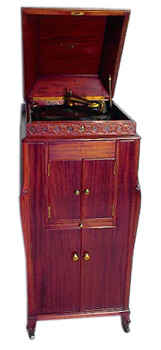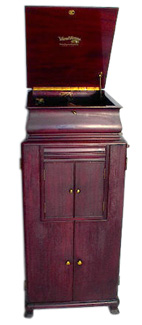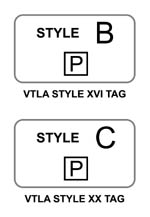by Loran T. Hughes



The Victor Victrola, the first phonograph to have its horn enclosed in a cabinet, began life on the drawing board as early as 1903. The first Victrola cabinets were manufactured by the Pooley Furniture Company in 1906. These L-door style cabinets were given VTLA (shorthand for VicTroLA) serial numbers. As cabinet production eventually moved into the Victor facilities, the VTLA designation and serial number series continued to be used on the newer Victrola styles.
| Serial No. | Style |
| 406 | Mertz |
| 1424 | Pooley |
| 1500 | Pooley |
| 1839 | Pooley |
| 4553 | XX |
| 5169 | XX |
| 5713 | XVI |
| 5786 | XX |
| 6045 | XVI |
| 7717 | XVI |
| 8330 | XX |
| 9651 | XVI |
| 11172 | XVI |
| 11596 | XVI |
On the surface, VTLA serial numbers don't seem to make much sense. The fact is that all pre-1909 Victrolas were lumped into the same VTLA serial number block, regardless of the cabinet style.
The chart on the left shows a sampling of surviving VTLA serial numbers. As you might expect, the earliest serial numbers correspond to the Mertz and Pooley cabinets. However, XVI and the short lived XX style serial numbers are intermixed.
Now for the bottom line - just how many VTLAs were manufactured? The current estimates are:
| Mertz & Pooley Style: | 2,500 |
| Style XVI: | 9,000 |
| Style XX: | 500 |
| Total: | 12,000 |
Accordingly, VTLA serial numbers ended in 1909 at about 12000. The XVI cabinet design was simplified, but retained the distinctive L-doors until serial number 60000 in 1912.

Each tag also shows the letter "P" inside a square. The meaning of this is unknown, but may be an indication that the Pooley Furniture Co. had a hand in producing these later cabinets as well.